History of Henry County, Alabama
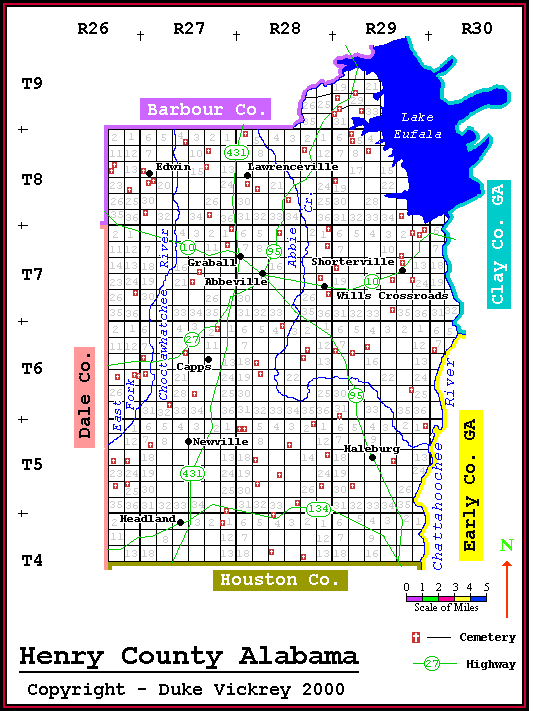
History of Henry County
Henry County was created on 1819 Dec. 13. The original county was vast in size,
until its boundaries were reduced by the establishment of the counties of Pike
and Covington in 1821, by Dale in 1824, by Barbour in 1832 and Houston in 1903.
The county was named for Revolutionary War patriot Patrick Henry (Virginia).
Henry County is located in the southeastern corner of the state, bounded to the
east by the State of Georgia and the Chattahoochee River. It encompasses 557
square miles. It is identified as part of the coastal plain or Wiregrass region.
The county seat is located in Abbeville. Other towns include Headland and
Newville.
Authority: Owen, Thomas McAdory. History of Alabama and Dictionary of Alabama
Biography. Chicago: S.J. Clarke Publishing Co., 1921.
Henry County was carved from Conecuh which had been a part of Monroe after it
was formed from Washington County, the oldest county in the state, having been
created by the proclamation of Governor Winthrop Sergeant of the Mississippi
Territory on June 4, 1800. The area of Henry County on December 13, 1819 was
vast in area. It embraced the present territory of Covington, Dale, Coffee,
Geneva, Henry, Houston, parts of Pike, Crenshaw, Bullock and Barbour. The
present area is 565 square miles. After the creation of Covington County from
Henry, a part of Conecuh was left south of Henry which was later added to Henry
County. Henry County was named for Patrick Henry, the Virginian known as the
“Fireball of the Revolution”, by the many first settlers from Virginia who came
to this section.
The act of Creation named William C. Watson, John Fannin, Joel T. McClendon,
Johnson Wright, Captain S. Smith as commissioners for the location of the seat
of justice and establishment of the boundaries of Henry County.
1822
– The first County seat was in Richmond, Henry County Alabama.
1826
– The first Courthouse was built in Columbia Henry County Alabama
1833
– Courthouse Built in Abbeville, Henry County Alabama
1845
– Courthouse Built in Abbeville, Henry County Alabama
1889
- Courthouse Built in Abbeville, Henry County Alabama
1966
– Current Courthouse Built in Abbeville, Henry County Alabama
 Henry County Courthouse
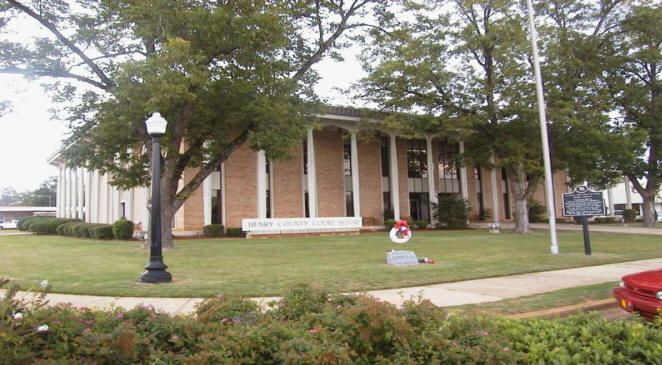
The Block House

Historical marker
about the Block House and John Whitehurst dated 1814.
Designated a Post Office
from 1833-1841. John Whitehurst was the first Postmaster.
Photo Owner: Wally Whitehurst
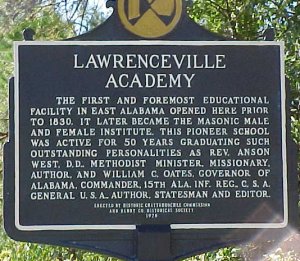

Old Linville Store
History
of the State of Alabama

The Alabama Great Seal
Graphic
provided by Information Services Division, Ala. Dept. of Finance
In
1817, when William Wyatt Bibb was appointed Governor of the brand new Alabama
territory, Bibb realized he needed an official seal for his commissions
and other state papers. With permission of President James Monroe and a
law adopted by Congress, the territorial governor was authorized to select
a design for a seal. Governor Bibb believed the best seal would be a map
of the territory showing its rivers. It also showed the territories (now
states) surrounding it.
By
1819, when Alabama became a state, the territorial seal was designated
by the first legislature as the state seal. The state seal remained unchanged
for 50 years, until the Recontruction period when a Republican-dominated
legislature had a new seal made. It consisted of an eagle perched upon
the shield of the United States seal. In the beak of the eagle was a banner
reading "Here We Rest". Around the new emblem were the words "Alabama Great
Seal". This seal was used for 71 years to authenticate official documents
and letterhead.
In
1939, a bill was introduced by the legislature to restore the original
seal as the Great Seal of Alabama. When the bill came up it was approved
unanimously by the Senate and the House. Governor Frank M. Dixon approved
the new law and the Secretary of State had a new Great Seal created. Act
no. 20.
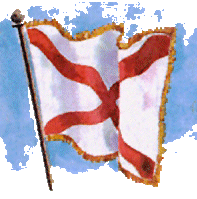
State
Flag of Alabama
The
present Alabama State Flag was authorized by the Alabama Legislature on
February 16, 1895, by act number 383. According to the Acts of Alabama,
1895, the state flag was to be a crimson cross of St. Andrew on a field
of white. The bars forming the cross were not to be less than six inches
broad and must extend diagonally across the flag from side to side. The
act does not designate a square or a rectangular flag.
Alabama's
past flags.
On
January 11, 1861, the Secession Convention passed a resolution designating
a flag designed by a group of Montgomery women as their official flag.
This flag has often been referred to as the Republic of Alabama Flag. One
side of the flag displayed the Goddess of Liberty holding in her right
hand an unsheathed sword; in the left a small flag with one star. In an
arch above this figure were the words "Independent Now and Forever." On
the other side of the flag was a cotton plant with a coiled rattlesnake.
Beneath the cotton plant are the Latin words: "Noli Me Tangere," (Touch
Me Not). This flag was flown until February 10, 1861, when it was removed
to the Governor's Office after it was damaged by severe weather. It was
never flown again.
From
March 4, 1861 until General James H. Wilson's occupation of Montgomery
in April 1865, a Confederate National Flag was flown, either the First
National Flag or the Second National Flag. After the end of the Civil War,
the United States Flag was used for all official occasions.
Display
- According to the Acts of Alabama, 2001-472: "
(a) Each facility of building
located in this state that is affiliated with any department or agency
of the state and supported in whole or in part by public funds, shall prominently
display the Alabama State Flag, in accordance with appropriate flag display
protocol, on a flag pole or flag poles located near the main entrance of
each facility or building. Any facility or building that is not in public
view or open to the general public, or is used only for storage or other
warehouse purposes, may be exempt from the requirements of this section
at the discretion of the director or chief official of the department or
agency.
(b)
Unless otherwise acquired pursuant to gift, donation, or other means, the
flags and flag poles required by this section shall be purchased by the
applicable department or agency within three years after August 21, 2001."
Under
an Act approved September 26, 1923, the flag of the State, as well as the
flag of the United States, is required to be displayed every day on which
school is in session, at all schools in the State which are supported even
in part by public funds. In 2001 the law was expanded to require state
flags to be flown at county courthouses, state offices, and municipal buildings.
Salute
- Flag of Alabama I salute thee. To thee I pledge my allegiance, my service,
and my life.
Source:
Act
1895-383, Acts of Alabama, February 16, 1895.
Act
23-444, Acts of Alabama, September 26, 1923.
Alabama
State Emblems, Alabama Department of Archives and History, nd.
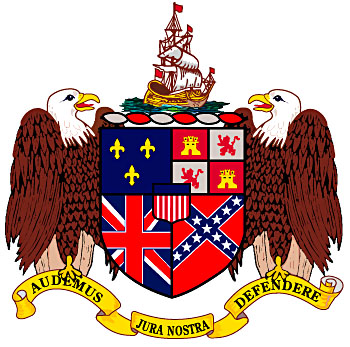
Official Alabama State
Coat of Arms
Image provided by Robert
Sears The bill to legalize a
state coat of arms was introduced in the Alabama Legislature of 1939 by
James Simpson, Jefferson County, and was passed without a dissenting vote
by both houses. The coat of arms consists of a shield on which appears
the emblems of the five governments that have held sovereignty over Alabama.
The flags of Spain, France, Great Britian, the Confederacy are bound by
the flag and shield of the United States. This shield is supported on either
side by bald eagles, symbolic of courage. The crest is a model of the ship,
the Baldine, that Iberville and Bienville sailed from France to settle
a colony near present day Mobile (1699). The motto beneath the shield is
"Audemus jura nostra defendere." Beneath the motto is the state name.
The original design of
the Alabama coat of arms was made in 1923 by B. J. Tieman, New York, an
authority on heraldry, at the request of Marie Bankhead Owen, Director
of the Department of Archives and History. A few years later Naomi Rabb
Winston, Washington, DC, painted the completed design in oil. Mrs. Owen
selected the motto which was put into Latin by Professor W.B. Saffold,
of the University of Alabama. It was through the influence of Juliet Perry
Dixon, wife of Governor Dixon, that official action was taken by the legislature.
The act to adopt an official
Coat-of-Arms for the State of Alabama was approved March 14, 1939, Act
no. 140.
Sources:
Acts of Alabama, March 14,
1939
Alabama State Emblems, Alabama
Department of Archives and History, n.d.
 State Flower, the
Camellia
State Flower, the
Camellia

State Wildflower
- Oak-leaf Hydrangea
AHGP Henry
County
|

